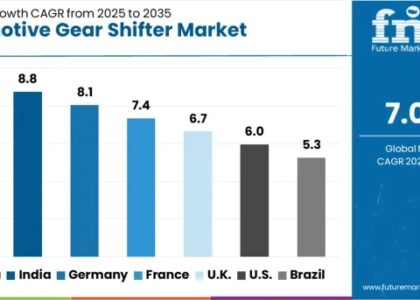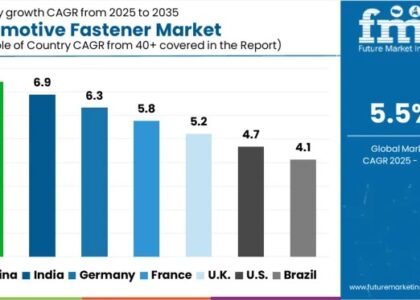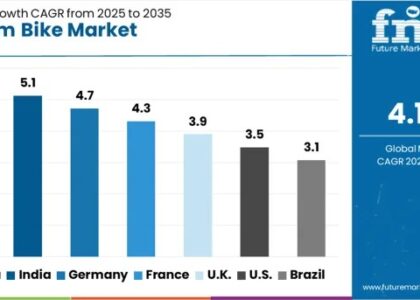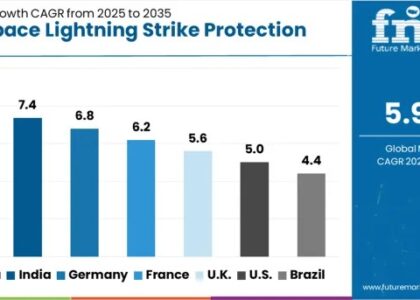Introduction
In the world of packaging, efficiency and convenience play a vital role. One of the unsung heroes in this domain is self-adhesive tear tape. This unassuming product might not be in the spotlight, but it significantly enhances packaging solutions across various industries. From consumer goods to pharmaceuticals, self-adhesive tear tape simplifies the opening of packages. In this article, we will explore the Self-adhesive Tear Tape Market and provide you with a comprehensive understanding of its applications, benefits, and frequently asked questions.
Theself-adhesive tear tapes market is registering a valuation of US$ 221.65 million in 2023 and is estimated to reach US$ 350.86 million by 2033. The market is securing a CAGR of 4.7% during the forecast period.
The United States is anticipated to dominate the global market by capturing a huge revenue during the forecast period. The rising demand for safe, convenient, and designer packaging among end-users is expanding the country’s market share. The popularity of pre-designed line packaging without any need for cutting is further driving market growth.
How Demand for Self-adhesive Tear Tapes Grows in the Packaging and Healthcare Sector?
The packaging and healthcare sectors are popularly growing huge revenue in the global market. The self-adhesive tear tapes are widely used due to their flexible, convenient, and easy packaging features. The manufacturers are increasing the adoption of these tapes to make them user-friendly in the packaging industry. The essential materials for self-adhesive tear tapes include envelopes, boxes, paper, and bags.
The self-adhesive tear tapes are significantly used for medical packaging to secure medical equipment, medicine, and other products. The rising demand for self-adhesive tear tapes among medical staff to stay safe and not open till received by the end users. These tapes offer tamper-evident protection to medical products and are surging the market revenue.
With the growing technological advancements, manufacturers can develop high-quality, efficient, customized self-adhesive tear tapes. Various businesses and industries prefer these self-adhesive tear tapes as a prior option for safe and secure packaging.
The manufacturers in healthcare and packaging industries are taking efforts to produce sustainable, clean, and eco-friendly tapes to decline hazardous environments. The healthcare and packaging industries are estimated to drive further in the coming years.
Key Takeaways:
- The United States is capturing a maximum share of 20.4% in the global market during the forecast period.
- The self-adhesive tear tapes market is securing a CAGR of 4.6% with a valuation of US$ 324.7 million by 2033.
- With a share of 6.3%, India is anticipated to expand the global market by 2033.
- China is contributing a share of 6% in the global market during the forecast period.
Market Drivers-
- Convenience in Packaging: Self-adhesive tear tape offers a convenient and user-friendly way to open packages. It is widely used in consumer products, enhancing the overall packaging experience.
- Anti-Counterfeiting Measures: Tear tape can be customized with security features, making it an effective tool against counterfeiting and tampering in various industries, including pharmaceuticals and tobacco.
- Packaging Efficiency: Tear tape simplifies the packaging process, making it faster and more efficient for manufacturers. This efficiency is crucial for high-speed packaging lines.
- Consumer Preference for Easy Opening: Consumers increasingly prefer packaging that is easy to open without the need for tools or additional materials. Tear tape fulfills this preference, enhancing consumer satisfaction.
- Branding and Marketing: Tear tape can be customized with branding, logos, and promotional messages. This not only serves as a marketing tool but also adds to the visual appeal of the product.
- Tamper Evidence: Tear tape can serve as a clear indicator of tampering or unauthorized access to a product, which is vital for maintaining product integrity, especially in the pharmaceutical and food industries.
- Sustainability and Recyclability: Many self-adhesive tear tapes are made from eco-friendly materials, which align with the growing demand for sustainable packaging solutions.
- Growth in E-commerce: The rise of e-commerce has increased the need for secure and easy-to-open packaging, making self-adhesive tear tape a valuable addition to parcel packaging.
Key Players’ Unique Strategies to Uplift the Global Market
The key players play a crucial role in uplifting the market revenue through their unique marketing strategies. Here are a few examples:
- 3M employs its unique strategy to innovate better adhesion, durable and strong tapes to stay ahead of competitors. The company invests its precious time in research and development activities to create new product solutions and better ideas that meet consumers’ desires.
- Tesa SE is innovating its customized product suitable to consumers’ satisfaction. They offer various services that build trustworthy relations with their consumers.
- A company in Japan, Nitto Denko Corporation provides highly specialized self-adhesive tear tapes that are 100% eco-friendly. They implement their products to reduce carbon emissions and promote green initiatives.
- Sekisui Chemicals Co., Ltd is another prominent company that creates strong, flexible self-adhesive tear tapes for customers. They are adopting coating technology to develop high-strength and water-resistance tear tapes.
Other Prominent Players Working in the Global Market are:
- DS Smith plc
- Bagla Group
- H.B. Fuller Company
- 3M Company
- Tesa SE
- Wavelock Advanced Technology Co., Ltd.
- Marotech Inc.
- Tann Germany GmbH
- Essentra Plc.
- NADCO Tapes & Labels, Inc.
- Uyumplast Ambalaj San.tic.ltd.?ti
Recent Developments in the Global Market are:
- In 2021, Tesa SE launched its new self-adhesive tear tape, providing tamper evidence in flexible packaging.
- In 2020, UPM Raflatac announced its newly launched product with tamper-evident label material widely used in pharmaceutical packaging.
- In 2019, 3M developed a wide range of high-quality self-adhesive tear tapes. It provides easy to close and open with the adoption of self-adhesive technology.
- In 2020, LINTEC Corporation announced its newly launched Lintec Cryogenic Tapes, especially for medical research centers.
Market Restraints-
- Cost Considerations: The initial cost of implementing tear tape into packaging can be a restraint, especially for smaller manufacturers. While it offers benefits, the expense may deter some companies.
- Compatibility Issues: Tear tape may not be compatible with all packaging materials or designs. Companies with specific packaging requirements may face limitations in its use.
- Environmental Concerns: While some self-adhesive tear tapes are eco-friendly, not all are. The environmental impact of tear tape production and disposal can be a concern in an era of increased focus on sustainability.
- Regulatory Compliance Challenges: Meeting regulatory standards for packaging materials, especially in industries like pharmaceuticals, can be complex and costly. Companies must ensure their tear tape adheres to these standards.
- Innovation and Customization Costs: Developing customized tear tapes with unique security features or branding can be expensive, potentially limiting adoption for some businesses.
- Complexity in Application: Applying self-adhesive tear tape to packaging requires machinery and precision. Smaller manufacturers or those without access to specialized equipment may find this challenging.
- Consumer Acceptance: While many consumers prefer easy-to-open packaging, not all may be familiar with self-adhesive tear tape. Companies need to educate consumers about the benefits and usage of tear tape.
- Alternative Opening Solutions: Some industries may prefer alternative opening solutions, such as pull-tabs or resealable packaging, which may be more suitable for their products and target audiences.
Key Segmentations-
By Width:
- Up to 2.5 mm
- 2.6 mm to 5.0 mm
- Above 5.0 mm
By Material Type:
Polypropylene
- Biaxially Oriented Polypropylene
- Cast Polypropylene
- Mono Oriented Polpropylene
- Polyvinyl Chloride
- Polyethylene Terephthalate
- Polyethylene
- Others
By End Use:
- Food
- Tobacco
- Pharmaceuticals
- Personal Care & Cosmetics
- Electrical & Electronics
- Others
Region:
- North America
- Europe
- Latin America
- Asia Pacific
- Middle East Africa
About Future Market Insights (FMI)
Future Market Insights, Inc. (ESOMAR certified, recipient of the Stevie Award, and a member of the Greater New York Chamber of Commerce) offers profound insights into the driving factors that are boosting demand in the market. FMI stands as the leading global provider of market intelligence, advisory services, consulting, and events for the Packaging, Food and Beverage, Consumer, Technology, Healthcare, Industrial, and Chemicals markets. With a vast team of over 5000 analysts worldwide, FMI provides global, regional, and local expertise on diverse domains and industry trends across more than 110 countries.
Contact Us:
Future Market Insights Inc.
Christiana Corporate, 200 Continental Drive,
Suite 401, Newark, Delaware – 19713, USA
T: +1-845-579-5705
For Sales Enquiries: sales@futuremarketinsights.com
Website: https://www.futuremarketinsights.com
LinkedIn| Twitter| Blogs | YouTube






